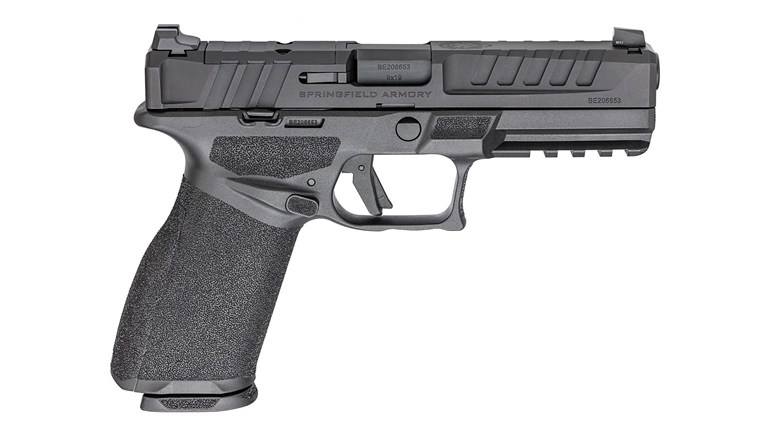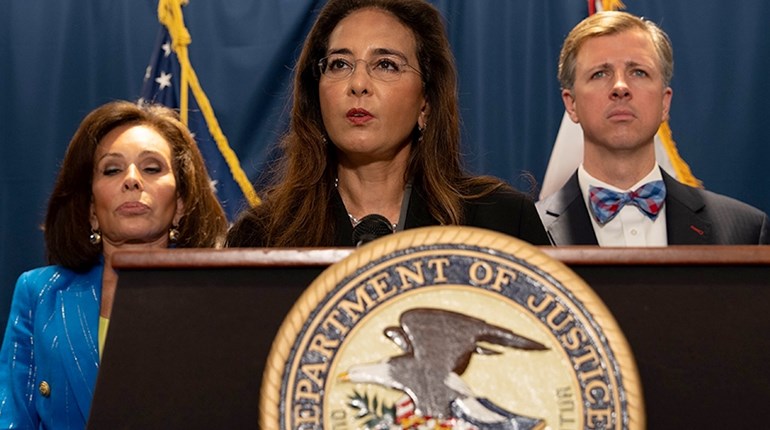
Early last February, Mike Gill, a former Trump administration official at the U.S. Commodity Futures Trading Commission, was fatally shot in a carjacking attack in Washington, D.C. Gill recently served as senior vice president for capital markets at the Housing. Policy Council. He was the father of three children.
A statement released by the D.C. Metropolitan Police Department explained that the murderer approached Gill’s parked vehicle on K Street, managed to get inside and then shot Gill. The suspect in the case, whom the police identified as Artell Cunningham, was subsequently shot and killed by the police, though not before Cunningham allegedly murdered another person.
Sadly, these incidents are hardly anomalies in our nation’s violence-infested capital.
Last year, Rep. Henry Cuellar (D-Texas) was also carjacked at gunpoint in D.C.’s bustling Navy Yard neighborhood. Rep. Angie Craig (D-Minn.) was assaulted inside her luxury apartment building, which prompted her to endorse tougher policies on crime.
Yet, crime continues to rise.
“All should feel safe in their nation’s capital city. But they don’t because of D.C. Democrats’ leniency toward criminals at the expense of Americans’ safety,” said House Oversight and Accountability Chair James Comer (R-Ky.) on X. “Ensuring public safety and addressing crime is a cornerstone of the House Republican’s policy agenda.”
Indeed, President Joe Biden (D) has failed in his basic responsibility to keep Americans safe, while continuing to support legislation written to deprive law-abiding citizens of the ability to protect themselves and their families.
In 2023, while reported rates of violent crime decreased in most major U.S. cities (relative to 2022), Washington, D.C., experienced a tragic increase. With a homicide rate of nearly 40 per 100,000, the city ranked fifth highest in the nation, following Memphis, St. Louis, Baltimore and Detroit. The year saw a significant rise in crime, with 274 homicides, marking a 35% increase from 2022, along with 3,470 robberies (a 67% increase), 6,829 car thefts (a 82% increase) and 13,349 thefts (a 23% increase). Overall, violent crime surged by 39%, while all crime increased by 26% compared to the previous year.
These statistics reflect the highest homicide total since the late 1990s, which serves as a bleak reminder of the District’s historical designation in the late 20th century as “America’s murder capital.”
So, what is behind this chilling spike?
In 2020, as the George Floyd protests gripped the nation amid pandemic lockdowns, the Council of the District of Columbia cut $15 million from the police budget in response to activists’ demands to defund law enforcement; as a result, by 2023, the staffing levels of the D.C. police force had plummeted to its lowest point in 50 years. The subsequent rise in crime soon sparked anger and frustration among many residents.
According to data published by The Washington Post in 2023, every police officer was saddled with responding to 23% more calls than the previous year, leading to a response time for the highest-priority calls that was one minute and 40 seconds slower than in 2019. As time can mean the difference between life and death, especially when one is deprived of one’s right to be armed for self-protection, this is likely part of the reason for the rise in the murder rate.
Last year, D.C. encountered its most-significant police deficit in approximately half a century, as it failed to fulfill recruitment goals or to offset attrition rates. While the city is not unique in grappling with staffing deficiencies as police nationwide are demoralized, its law-enforcement personnel have also been making substantially fewer arrests than in previous years. D.C. Crime Facts reported a 44% decline in arrest rates per officer in 2022, dropping from an average of 7.8 arrests per officer annually during 2014-2019 to approximately 4.4 in 2022. Moreover, the number of arrests decreased in areas of high and rising crime despite decades of research indicating that heavier police deployment to “hot spots” is a successful blueprint for crime reduction.
When police departments are understaffed, officers may find it challenging to promptly address service calls, which leaves them with limited opportunities to establish vital community connections. Without these relationships, residents may hesitate to report crimes or to provide witness testimony.
The decline in law-enforcement personnel has resulted in fewer arrests and in a reduction in the number of cases being solved and prosecuted. Among those apprehended, fewer individuals are facing charges. Analysis conducted by the Washington City Paper in 2023 on data from the U.S. Attorney’s Office revealed that out of 15,315 arrests conducted by Metro Police officers in the fiscal year 2022, the U.S. Attorney’s Office opted not to prosecute 10,261 cases, which means that over 67% of those arrested were not prosecuted. In 2023, the D.C. police solved only 45% of homicides—the lowest rate in over 15 years.
Fewer arrests means that more criminals can continue to take lives. A study by the National Institute for Criminal Justice Reform highlighted that the overwhelming majority of criminal firearm misuse in the capital is driven by a “tightly concentrated” group of career criminals.
Most “suspects with prior criminal offenses had been arrested about 11 times for about 13 different offenses by the time of the homicide,” the study observed.
Much of this ongoing stupidity can be pegged on Matthew Graves, the Democratic Party’s championed U.S. attorney for the District of Columbia, as he refuses to take crime prevention seriously; for example, while there were at least 958 carjackings in D.C. last year, of which more than 77% involved a criminal with a gun, the police closed just 260 cases. Some 62% of those arrested for carjacking were juveniles—some were as young as 12, but the majority were around the age of 16. Graves declined to prosecute most of them as adults, which essentially freed them back onto the streets to continue waging war on citizens.
Despite this swell in crime, Graves’ office, which has about 330 prosecutors, has a case declination (they decline to prosecute) rate of 67%. Graves has attempted to shift blame for this issue onto various entities, including the courts and the police, but critics aren’t buying it.
“The real problem is Graves. He refuses to prosecute every case to the fullest extent of the law, pure and simple. As long as his charging policies remain the same, sending his office more prosecutors from Justice won’t make a difference,” said Zack Smith and Charles Stimson, senior legal fellows at The Heritage Foundation. “The vast majority of violent crimes are committed by a few hundred armed career criminals who act with impunity because they know the local prosecutor won’t put them in prison for their crimes. Full stop.”
Imagine if Graves were to pursue charges against every individual found in possession of an illegal firearm. Instead, even as the crime problem increases, he instructs his prosecutors to send gun cases committed by convicted felons to the Superior Court for the District of Columbia. There, they often negotiate those cases to significantly reduced charges, which results in many criminals receiving probation instead of the lengthy prison sentences they would have faced if their cases were brought to the federal district court. This policy decision is within Graves’ power to change immediately, but it doesn’t fit the far-Left’s nonsensical anti-law-and-order agenda.
But, it seems D.C. residents are starting to wake up. Writers at the The Washington Post, a corporate media outlet that loathes the citizens’ right to keep and bear arms, appeared surprised recently when interviewing locals about what was needed to turn those soaring crime rates around.
“We need more police officers so they are visible and can respond to crime as it is happening,” said D.C. resident K.D. Turner. “I called 911 when some young people were trying to break into a neighbor’s house and then they started harassing me, but no one ever came.”
Another said, “To reduce crime in D.C., I would get the police out of their cars and onto the streets. Sitting in their cars, officers can all too easily be on their phones or otherwise distracted. Even if they are stationed on the street with their cars, they should be outside their vehicles, visible to the public and paying attention. Current and potential carjackers need to know the police will catch them and prosecutors will employ the full extent of the law against them. Juvenile armed carjackers need to know that the justice system will prosecute them as adults, without opportunities for diversion programs or other second-chance options.”
Still, instead of going to the root of the problem, politicians with Biden’s brand of politics continue to point fingers at guns and the law-adhering citizens who endeavor to utilize their constitutional rights. In his bid for reelection, Biden has made gun control—not law and order—central to his campaign.
“Washington, D.C., has enacted some of the strongest gun violence prevention legislation in the nation,” boasted the anti-gun group Giffords Law Center. “Washington, D.C., requires all guns to be registered and has high standards for the types of guns that can be owned or possessed.”

The group praises D.C. for its litany of gun-control measures, including lengthy waiting periods, no reciprocity for carry permits issued by other jurisdictions, magazine-capacity prohibitions and onerous concealed-carry laws, yet they fail to point out that criminals are still well-armed.
Instead of stopping the bad guys, Washington, D.C., has forced residents to continue to endure a daunting and laborious process just to purchase firearms. This entails extensive paperwork, registration requirements, high fees and strict purchasing limits. And, for a long time, firearm transfers could only be processed at one location, which charged an additional $125 fee and didn’t even sell guns, but only handled transfers from outside jurisdictions; however, in 2020, amidst a surge in crime during the pandemic, the owner of that location closed shop due to increased burdens imposed on his business by D.C.
District of Columbia Mayor Muriel Bowser (D), known for supporting gun-control policies and approving of cuts to law enforcement, responded by announcing that the Metropolitan Police Department would take over transfer duties, but this led to even more problems and even to ATF investigations of the police. By January 2021, two new Federal Firearms Licensees (FFL) were licensed in D.C., but they only facilitated firearm transfers without selling firearms within the District.
Even though obtaining a permit to carry concealed finally became attainable when courts struck down a ban on D.C. concealed-carry permits as unconstitutional, the anti-Second Amendment leadership still does whatever they can to hinder what should be a straightforward process.
One individual who attempted to navigate the “stressful process” of obtaining a concealed-carry permit in D.C. last year pointed out that first, one must complete a firearms-safety class. Then, if purchasing a firearm online or from an FFL outside of D.C., a $125 transfer fee is required for D.C. residents. The individual stressed that the real frustration sets in when a person must schedule a D.C. concealed-carry appointment and firearms registration, which often has a wait time of three or four months.
“Even after securing an appointment, the process is far from over. Submitting paperwork and fingerprints to MPD can take an additional one to four months for approval,” the person explained. “Finally, after a possible seven months of waiting, another appointment must be made with the FFL to pick up the firearm.”
Elsewhere in the nation, more and more people are refusing to remain sitting ducks to criminality. Data from the firearm industry indicates that March 2024 marked the 56th consecutive month with over one million FBI National Instant Criminal Background Check System verifications for likely firearm purchases. Additionally, approximately 30% of these purchases were made by first-time gun buyers.
Unfortunately, Washington, D.C., and similar anti-Second Amendment jurisdictions, persist in imposing onerous regulations on lawful gun ownership while overlooking the pervasive criminal activity afflicting their cities. By enacting laws that disproportionately burden law-abiding gun owners while showing leniency toward criminals, officials in D.C. are effectively saying that residents must accept being potential victims.


































